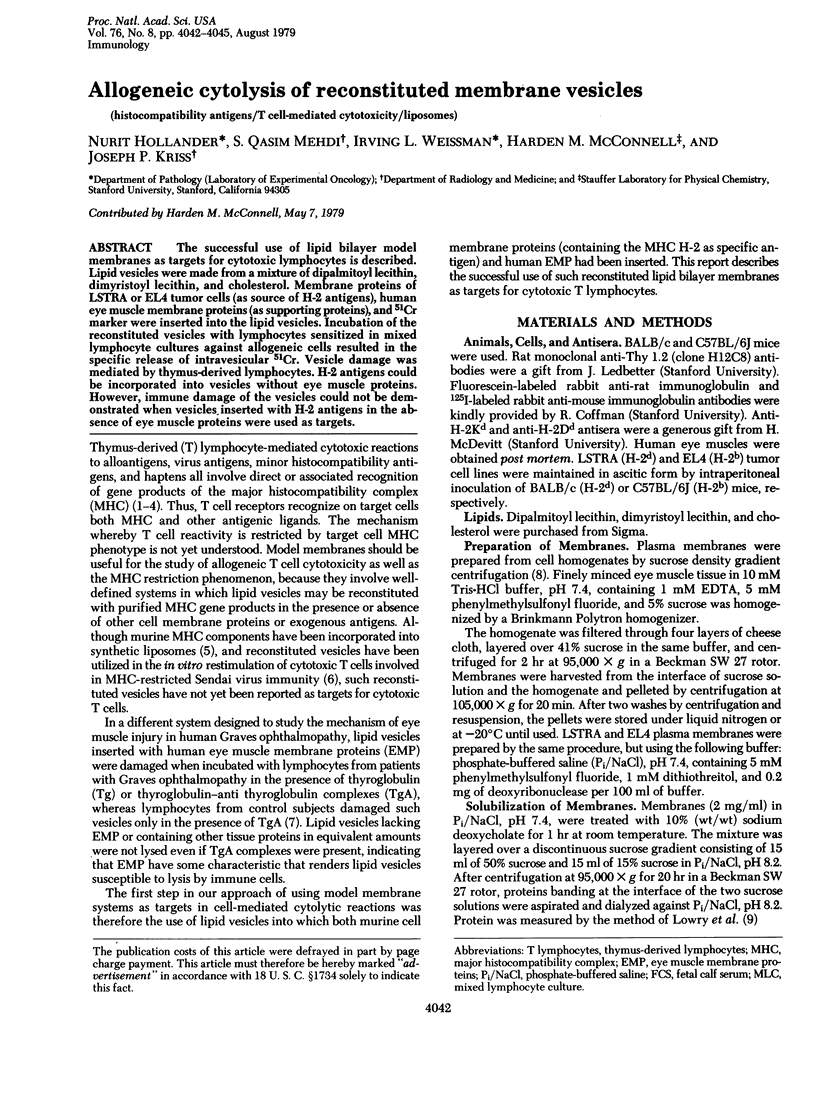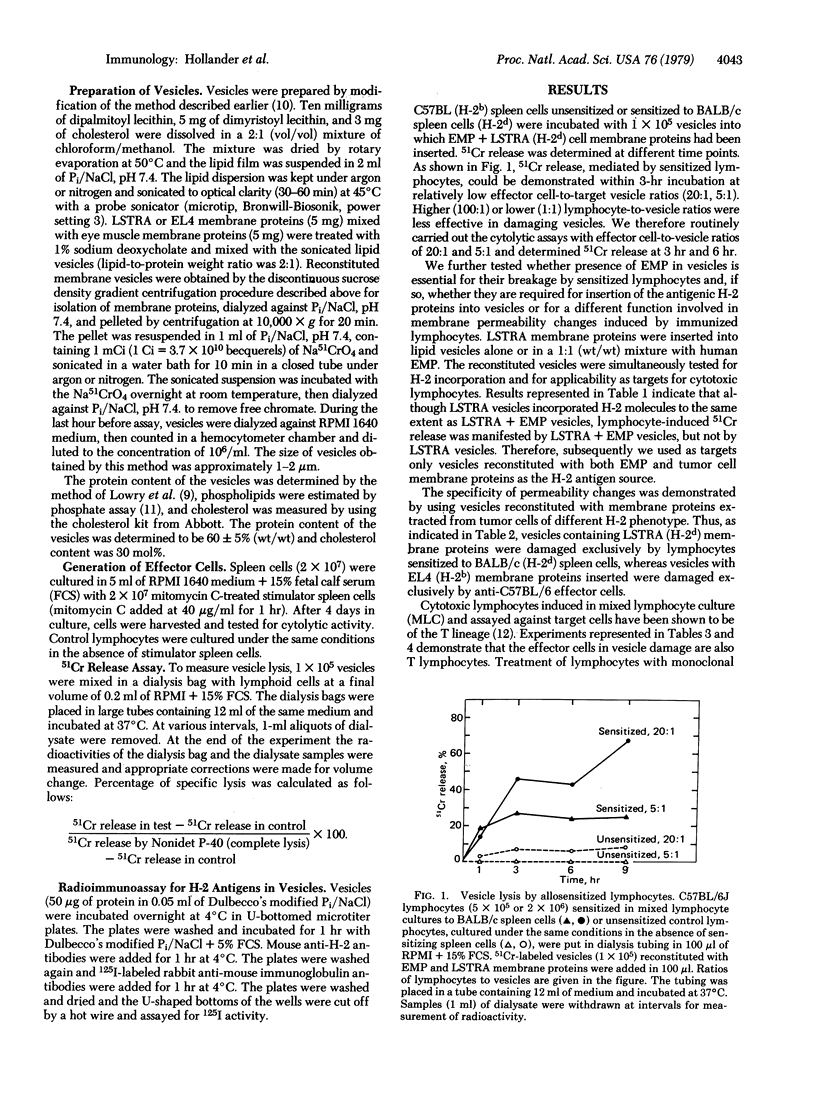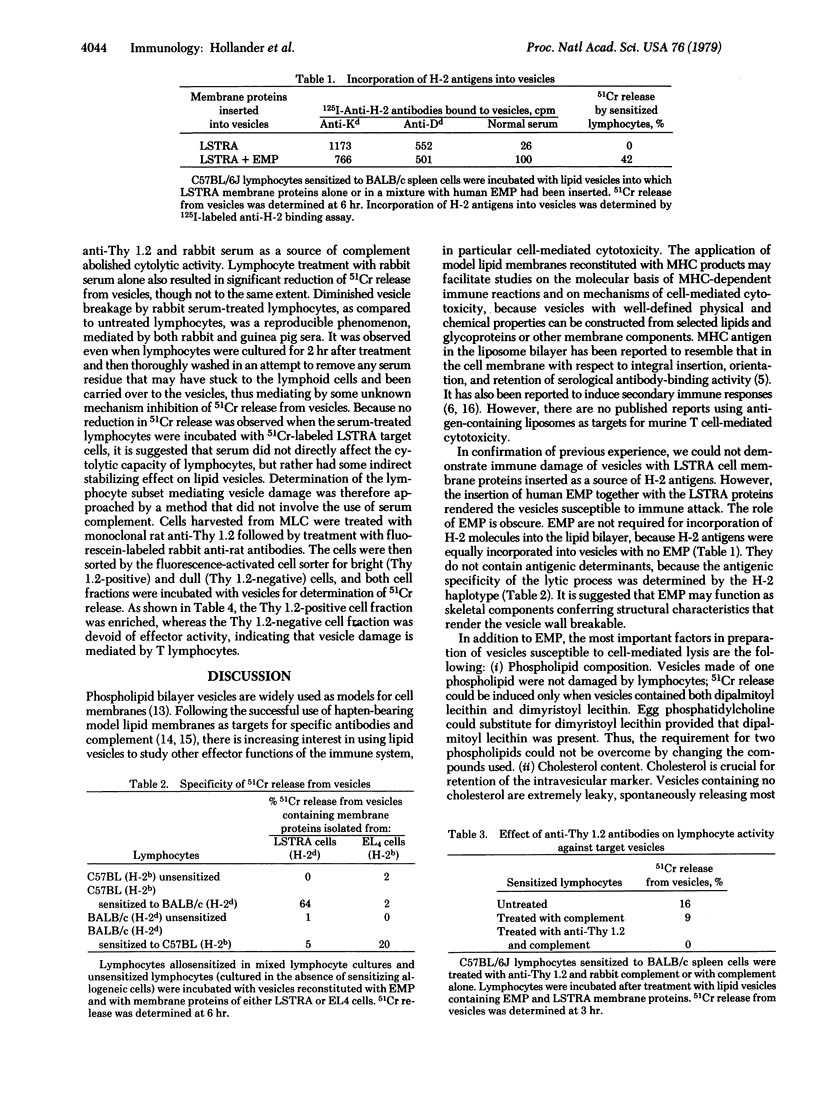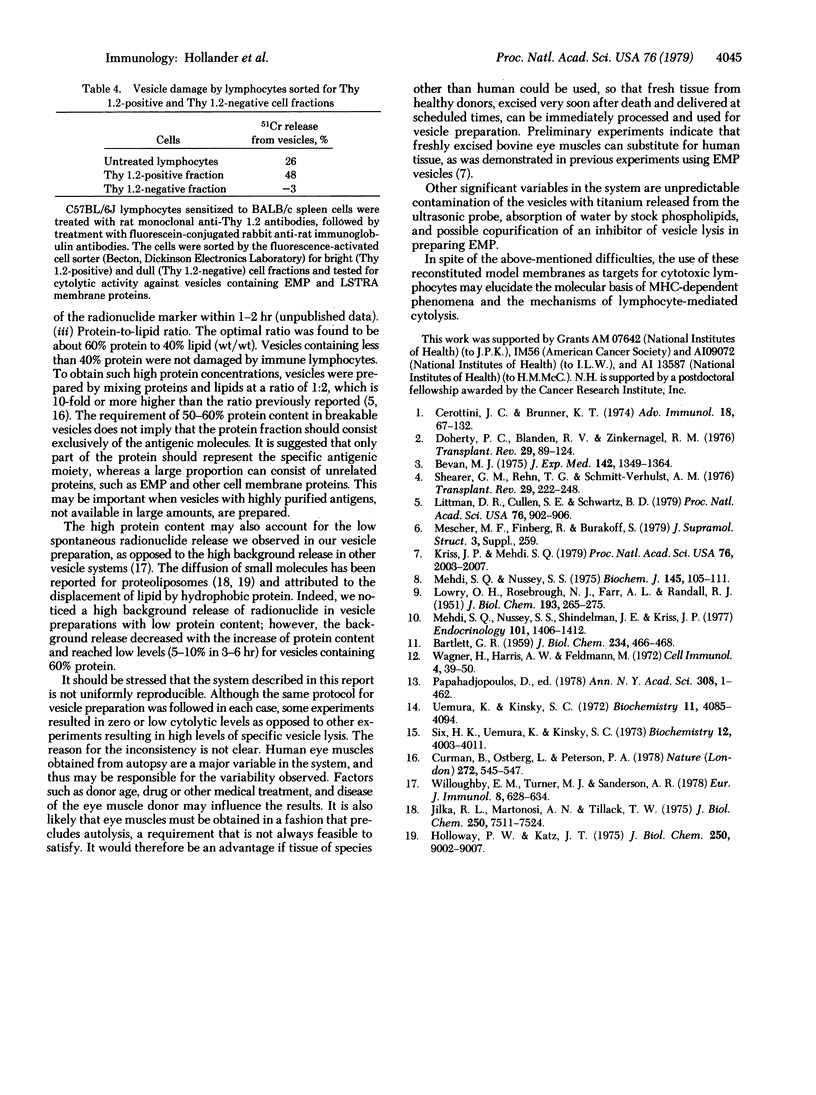Abstract
The successful use of lipid bilayer model membranes as targets for cytotoxic lymphocytes is described. Lipid vesicles were made from a mixture of dipalmitoyl lecithin, dimyristoyl lecithin, and cholesterol. Membrane proteins of LSTRA or EL4 tumor cells (as source of H-2 antigens), human eye muscle membrane proteins (as supporting proteins), and 51Cr marker were inserted into the lipid vesicles. Incubation of the reconstituted vesicles with lymphocytes sensitized in mixed lymphocyte cultures against allogeneic cells resulted in the specific release of intravesicular 51Cr. Vesicle damage was mediated by thymus-derived lymphocytes. H-2 antigens could be incorporated into vesicles without eye muscle proteins. However, immune damage of the vesicles could not be demonstrated when vesicles inserted with H-2 antigens in the absence of eye muscle proteins were used as targets.
Full text
PDF



Selected References
These references are in PubMed. This may not be the complete list of references from this article.
- BARTLETT G. R. Phosphorus assay in column chromatography. J Biol Chem. 1959 Mar;234(3):466–468. [PubMed] [Google Scholar]
- Bevan M. J. The major histocompatibility complex determines susceptibility to cytotoxic T cells directed against minor histocompatibility antigens. J Exp Med. 1975 Dec 1;142(6):1349–1364. doi: 10.1084/jem.142.6.1349. [DOI] [PMC free article] [PubMed] [Google Scholar]
- Cerottini J. C., Brunner K. T. Cell-mediated cytotoxicity, allograft rejection, and tumor immunity. Adv Immunol. 1974;18:67–132. doi: 10.1016/s0065-2776(08)60308-9. [DOI] [PubMed] [Google Scholar]
- Curman B., Ostberg L., Peterson P. A. Incorporation of murine MHC antigens into liposomes and their effect in the secondary mixed lymphocyte reaction. Nature. 1978 Apr 6;272(5653):545–547. doi: 10.1038/272545a0. [DOI] [PubMed] [Google Scholar]
- Doherty P. C., Blanden R. V., Zinkernagel R. M. Specificity of virus-immune effector T cells for H-2K or H-2D compatible interactions: implications for H-antigen diversity. Transplant Rev. 1976;29:89–124. doi: 10.1111/j.1600-065x.1976.tb00198.x. [DOI] [PubMed] [Google Scholar]
- Holloway P. W., Katz J. T. Effect of cytochrome b5 on the size, density, and permeability of phosphatidylcholine vesicles. J Biol Chem. 1975 Dec 10;250(23):9002–9007. [PubMed] [Google Scholar]
- Jilka R. L., Martonosi A. N., Tillack T. W. Effect of the purified (Mg2+ + Ca2+)-activated ATPase of sarcoplasmic reticulum upon the passive Ca2+ permeability and ultrastructure of phospholipid vesicles. J Biol Chem. 1975 Sep 25;250(18):7511–7524. [PubMed] [Google Scholar]
- Kriss J. P., Mehdi S. Q. Cell-mediated lysis of lipid vesicles containing eye muscle protein: implications regarding pathogenesis of Graves ophthalmopathy. Proc Natl Acad Sci U S A. 1979 Apr;76(4):2003–2007. doi: 10.1073/pnas.76.4.2003. [DOI] [PMC free article] [PubMed] [Google Scholar]
- LOWRY O. H., ROSEBROUGH N. J., FARR A. L., RANDALL R. J. Protein measurement with the Folin phenol reagent. J Biol Chem. 1951 Nov;193(1):265–275. [PubMed] [Google Scholar]
- Littman D. R., Cullen S. E., Schwartz B. D. Insertion of Ia and H-2 alloantigens into model membranes. Proc Natl Acad Sci U S A. 1979 Feb;76(2):902–906. doi: 10.1073/pnas.76.2.902. [DOI] [PMC free article] [PubMed] [Google Scholar]
- Mehdi S. Q., Nussey S. S. A radio-ligand receptor assay for the long-acting thyroid stimulator. Inhibition by the long-acting thyroid stimulator of the binding of radioiodinated thyroid-stimulating hormone to human thyroid membranes. Biochem J. 1975 Jan;145(1):105–111. doi: 10.1042/bj1450105. [DOI] [PMC free article] [PubMed] [Google Scholar]
- Mehdi S. Q., Nussey S. S., Shindelman J. E., Kriss J. P. The influence of lipid substitution on thyrotropin-receptor interactions in artificial vesicles. Endocrinology. 1977 Nov;101(5):1406–1412. doi: 10.1210/endo-101-5-1406. [DOI] [PubMed] [Google Scholar]
- Shearer G. M., Rehn T. G., Schmitt-Verhulst A. M. Role of the murine major histocompatibility complex in the specificity of in vitro T-cell-mediated lympholysis against chemically-modified autologous lymphocytes. Transplant Rev. 1976;29:222–246. doi: 10.1111/j.1600-065x.1976.tb00203.x. [DOI] [PubMed] [Google Scholar]
- Six H. R., Uemura K. I., Kinsky S. C. Effect of immunoglobulin class and affinity on the initiation of complement-dependent damage to liposomal model membranes sensitized with dinitrophenylated phospholipids. Biochemistry. 1973 Sep 25;12(20):4003–4011. doi: 10.1021/bi00744a034. [DOI] [PubMed] [Google Scholar]
- Uemura K., Kinsky S. C. Active vs. passive sensitization of liposomes toward antibody and complement by dinitrophenylated derivatives of phosphatidylethanolamine. Biochemistry. 1972 Oct 24;11(22):4085–4094. doi: 10.1021/bi00772a010. [DOI] [PubMed] [Google Scholar]
- Wagner H., Harris A. W., Feldmann M. Cell-mediated immune response in vitro. II. The role of thymus and thymus-derived lymphocytes. Cell Immunol. 1972 May;4(1):39–50. doi: 10.1016/0008-8749(72)90004-4. [DOI] [PubMed] [Google Scholar]
- Willoughby E. M., Turner M. J., Sanderson A. R. Incorporation of rat histocompatibility (AgB) antigens into liposomes, and their susceptibility to immune lysis. Eur J Immunol. 1978 Sep;8(9):628–634. doi: 10.1002/eji.1830080905. [DOI] [PubMed] [Google Scholar]


